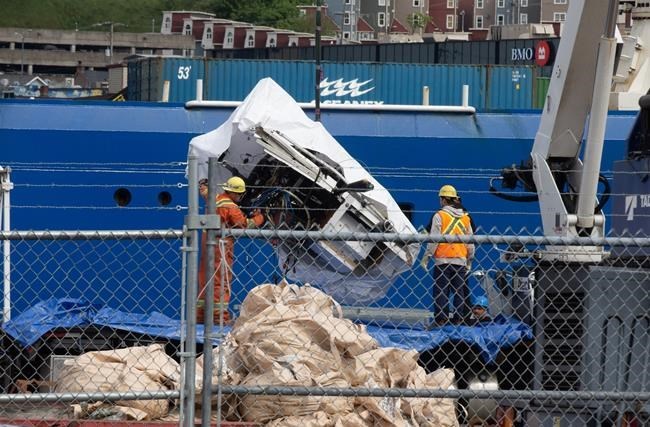EAST AURORA, N.Y. — The owner of a remotely operated vehicle that recovered pieces of the Titan submersible from the depths of the North Atlantic last week says his ROV found debris from the doomed vessel shortly after reaching the search site.
Ed Cassano, CEO of Pelagic Research Services, said Friday that his company was contacted by the owners of the Titan — OceanGate Expeditions — on June 18, shortly after the submersible lost contact with its mother ship during a dive to the wreck of the Titanic.
“We were asked to activate our deep water remotely operated vehicle system Odysseus 6K and we immediately began assembling a team,” Cassano told a news conference in East Aurora, N.Y.
He said his team started assembling more than 31,000 kilograms of equipment at the Buffalo airport on June 19, adding that it took less than 30 hours to finish and transport it from Buffalo, N.Y., to St. John’s aboard three U.S. military heavy-lift aircraft.
By the time his team arrived at the search site on June 22, located in the North Atlantic about 700 kilometres south of Newfoundland, Cassano said 10 other vessels and aircraft were already scouring the area. His company's ROV, which was aboard the Canadian-owned ship Horizon Arctic, was deployed within an hour, he said.
The operation began as a rescue mission, he said, but that soon changed. “Shortly after arriving on the sea floor we discovered the debris of the Titan submersible. Sadly, a rescue had turned into a recovery.”
U.S. Coast Guard officials have said the ROV spotted the wreckage about 500 metres from the bow of the sunken Titanic.
Cassano said his crew returned to St. John’s on Wednesday with the pieces of Titan wreckage that it had been directed by search commanders to recover from the ocean floor.
He said the rescue proved challenging because of the depth of the Titanic wreck, which was almost four kilometres below the sea surface. Another ROV that was dispatched for the search and operated from the vessel Deep Energy dived beyond its depth capabilities and was lost, Cassano said. Pelagic Services later explained the ROV was removed from the search and did not physically go missing.
“We (searchers) pushed some things and everybody pushed some things on this response,” Cassano said.
The Titan imploded during its descent resulting in the deaths of all five passengers and crew. Stockton Rush, CEO of OceanGate, was piloting the submersible, which was carrying passengers British billionaire Hamish Harding, French explorer and Titanic expert Paul-Henry Nargeolet, and Pakistani businessman Shahzada Dawood and his 19-year-old son, Suleman.
The U.S. Coast Guard, which is leading an international investigation that also involves Canada’s Transportation Safety Board, said late Wednesday “presumed human remains” had been found in the Titan wreckage.
But officials from Pelagic declined to discuss any details related to the investigation.
Cassano also declined to give an opinion on Oceangate’s operation, which began taking tourists to the wreck of the famous luxury liner in 2021.
“Explorers, people who seek to be on the ocean and to go to depth, it’s very compelling,” he said. “We certainly share those desires; our whole company is designed to support research and science at depth."
This report by The Canadian Press was first published June 30, 2023.
Keith Doucette, The Canadian Press



